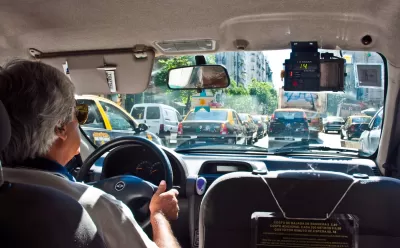The "universal visitation law of human mobility" documented in a newly published study in Nature offers predictive power for urban mobility in addition to empirical validation of Central Place Theory.

A study published last week in Nature reveals a "universal visitation law of human mobility" that could enable new ways to predict the way people move in and around cities all over the globe.
An article by Becky Ferreira shares news of the study led by researchers at MIT’s Senseable City Laboratory, who spent years tapping into anonymized mobile phone data in seven cities representing four continents: Greater Boston, USA; Singapore; Dakar, Senegal; Abidjan, Ivory Coast; and the Portuguese cities of Lisbon, Porto and Braga.
According to Ferreira's explanation, previous mobility research has overlooked "frequency of visitation," which proved to be the key to the advancement in the recent study, namely, the discovery of a "very clear" mathematical law that offers a universal visitation law of human mobility.
Ferreira summarizes the finding thusly:
Despite the dazzlingly distinct skylines, demographics, and characters of the studied cities, the researchers found that their residents and visitors all adhered to this universal visitation law, as described in the study: “the number of visitors to any location decreases as the inverse square of the product of their visiting frequency and travel distance.”
Of tremendous relevance to planners, "the new approach can provide more accurate predictions about all kinds of urban exchanges and encounters."
Ferreira also reports another consequences of the study's discover of the universal visitation law of human mobility: "The new law also provides empirical validation for established theories about human mobility such as the Central Place Theory, which suggests that people visit the closest possible location for their needs or wants, leading to distinct clusters within settlements."
FULL STORY: Millions of People's Location Data Revealed a 'Universal' Pattern In Study

Alabama: Trump Terminates Settlements for Black Communities Harmed By Raw Sewage
Trump deemed the landmark civil rights agreement “illegal DEI and environmental justice policy.”

Planetizen Federal Action Tracker
A weekly monitor of how Trump’s orders and actions are impacting planners and planning in America.

The 120 Year Old Tiny Home Villages That Sheltered San Francisco’s Earthquake Refugees
More than a century ago, San Francisco mobilized to house thousands of residents displaced by the 1906 earthquake. Could their strategy offer a model for the present?

In Both Crashes and Crime, Public Transportation is Far Safer than Driving
Contrary to popular assumptions, public transportation has far lower crash and crime rates than automobile travel. For safer communities, improve and encourage transit travel.

Report: Zoning Reforms Should Complement Nashville’s Ambitious Transit Plan
Without reform, restrictive zoning codes will limit the impact of the city’s planned transit expansion and could exclude some of the residents who depend on transit the most.

Judge Orders Release of Frozen IRA, IIJA Funding
The decision is a victory for environmental groups who charged that freezing funds for critical infrastructure and disaster response programs caused “real and irreparable harm” to communities.
Urban Design for Planners 1: Software Tools
This six-course series explores essential urban design concepts using open source software and equips planners with the tools they need to participate fully in the urban design process.
Planning for Universal Design
Learn the tools for implementing Universal Design in planning regulations.
Clanton & Associates, Inc.
Jessamine County Fiscal Court
Institute for Housing and Urban Development Studies (IHS)
City of Grandview
Harvard GSD Executive Education
Toledo-Lucas County Plan Commissions
Salt Lake City
NYU Wagner Graduate School of Public Service





























